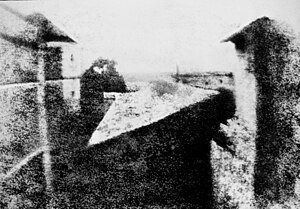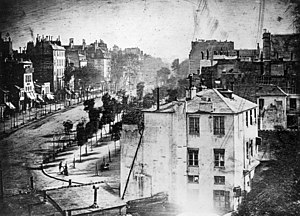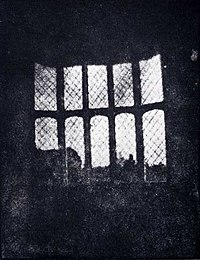The first attempts to capture an image were made from a camera obscura used since the 16th century. The device consists of a box or small room with a small hole in one side that acts as a lens. Light from an external scene passes through the hole and strikes the opposite surface inside where it is reproduced upside-down, but with color and perspective preserved. The image is usually projected onto paper adhered to the opposite wall, and can then be traced to produce a highly accurate representation. Experiments in capturing images on film had been conducted in Europe since the late 18th century.

Nicéphore Niépce's earliest surviving camera photograph, circa 1826:
View from the Window at Le GrasUsing the camera obscura as a guide, early photographers found ways to chemically fix the projected images onto plates coated with light sensitive materials. Moreover, they installed glass lenses in their early cameras and experimented with different exposure times for their images.
View from the Window at Le Gras (shown at right) is one of the oldest existing photographs, taken in 1826 by French inventor
Joseph Nicéphore Niépce using a process he called
heliograpy (“helio” meaning sun and “graph” meaning write). The exposure for the image took eight hours, resulting in the sun casting its light on both sides of the houses in the picture.

1. Large aperture
2. Small aperture
Further developments resulted in
apertures -- thin circular devices that are calibrated to allow a certain amount of light onto the exposed film. A wide aperture is used for low light conditions, while a smaller aperture is best for bright conditions. Apertures allowed photographers better control over their exposure times.

Louis Daguerre,
Boulevard du Temps, 1838.
During the 1830’s, Louis Daguerre, having worked with Niepce earlier, developed a more reliable process to capture images on film by using a polished copper plate treated with silver. He termed the images made by this process Daguerreotypes. They were sharper in focus and the exposure times were shorter. His photograph Boulevard du Temp from 1838 is taken from his studio window overlooking a busy Paris street. Still, with an exposure of ten minutes, none of the moving traffic or pedestrians stayed still long enough to be recorded. The only person in the image is a man on the lower left, standing at the corner getting his shoes shined.

William Henry Fox Talbot,
Latticed Window at Lacock Abbey, 1835. Photographic print. National Media Museum, West Yorkshire, England
At the same time in England, William Henry Fox Talbot was experimenting with other photographic processes. He was creating
photogenic drawings by simply placing objects (mostly botanical specimens) over light sensitive paper or plates, then exposing them to the sun. By 1844, he had invented the
calotype; a photographic print made from a
negative image. In contrast, Daguerreotypes were single, positive images that could not be reproduced. Talbot’s calotypes allowed for multiple prints from one negative, setting the standard for the new medium. “
Latticed Window at Lacock Abbey” is a print made from the oldest photographic negative in existence.

|




